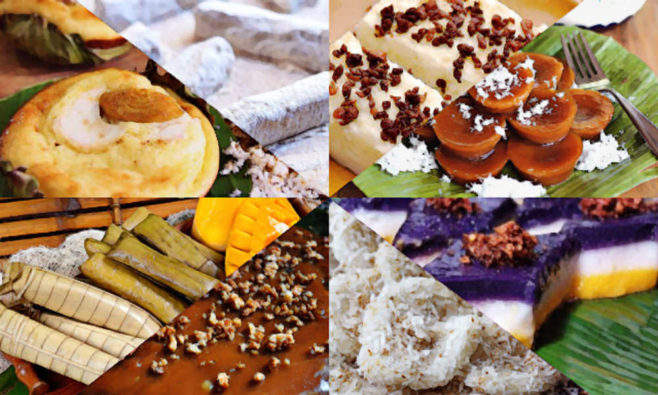Back in the early 1970s when we lived in an apartment in Frisco, Quezon City, we would patiently wait for the kutsinta man to make his rounds in our neighborhood. We would get excited and go outside upon hearing the sound of his horn echoing in the distance. Kutsinta man would then put down the conical aluminium containers and slowly open them up for us, revealing sweet goodies like kutsinta, puto, sapin-sapin, biko and palitaw.
Ask any Pinoy and they will tell you that Ronald McDonald or Jollibee has nothing on their favorite kakanin sold by their neighborhood suki. After a long day at school or the office, a slice of sapin-sapin or a couple of pieces of palitaw are what most of us Pinoys crave for. We just can’t help it because it’s practically in our blood and genes.
The name kakanin is derived from the Tagalog words kain (to eat) and kanin (rice). It is a term used for sweet snacks made of malagkit na bigas (glutinous rice) and gata (coconut milk), two main ingredients that tropical countries like the Philippines have in abundance. These ingredients are usually used in one of two forms. Some recipes use galapong which is made by soaking rice flour overnight then grinding and straining it using a cheese cloth. Other kinds of kakanin use simple malagkit or sticky rice grains that are either ground up or left whole.
Sweetened with sugar, wrapped in banana leaves and traditionally steamed in a special clay stove called a bibingkahan, sticky cakes were initially made to serve as offerings to our pre-colonial gods or as gifts to honored guests and visitors. While the bibingkahan clay stove is now rare and hard to find, many of the old, original recipes and cooking methods for making kakanin has survived the passage of time and are still used today.
All kinds of kakanin have its own unique and quirky name. Each kakanin carries with it a history that is rich and deeply-rooted in Pinoy culture as the delicacy it identifies.
Biko
A favorite at fiestas, weddings and funerals, biko is what usually comes to mind when you hear the word kakanin. These rice cakes are made with malagkit rice, coconut milk and a dark brown topping (latik). Gooey, sticky and with a distinct nutty sweetness, biko is one Pinoy delicacy that is difficult to put down after having tasted a bite.
Biko takes its name from the coffee-colored sweet coconut curd that gives it its distinctive flavor. The sticky cakes are also sometimes referred to as kalamay although the term only pertains to the coconut milk, brown sugar and glutinous rice powder mixture that are sometimes spread over the biko.
Puto
One of the most popular kakanin, puto (steamed rice cake) is traditionally white in color, although it can also be green or purple to indicate that it has been flavored with pandan or ube. Like the French baguette, puto is sometimes eaten along with savory viands like dinuguan. Toppings for puto range from a single strip of cheese or a slice of itlog na maalat (salted egg).
Puto comes from the Malay word puttu which literally means partitioned. The regional variants of puto take their names from either their appearance or most notable feature. Puto bumbong is named after the chimney-like apparatus used to cook it, puto seco is Spanish for dry puto, with its biscuit-like texture and bite-sized cakes with a sweet meat filling are called puto pao as a tribute to the Chinese meat bun that inspired their creation.
Sapin-sapin
Made with gulapong, coconut milk, sugar, condensed milk and ube, langka or cheese flavoring, sapin-sapin is sometimes referred to as a sweetened and coconut-infused blancmange by foreigners who get to taste it for the first time. Sapin-sapin has a dense, pudding-like texture and is usually served at fiestas, Christmas parties, birthdays and barangay election victory banquets.
Sapin-sapin is a Tagalog word for layers, a word which evokes this sticky dessert’s appearance and taste. When making sapin-sapin one must be sure that each layer of the glutinous rice batter is allowed to steam and set before the next layer is poured in to keep the vibrant colors and flavors separate and intact.
Bilo-bilo
Afternoons spent at Lola’s house in the province aren’t complete without a bowl of hot, steaming ginataang bilo-bilo, a staple comfort food come merienda time. Ginataang bilo-bilo is basically a mixture of diced kamote or ube, slices of saging na saba and chewy malagkit na bigas balls. These are cooked together in a soupy gruel thickened with fresh coconut milk and starch from the sliced tubers. Strips of langka (jack fruit) are sometimes added to give the ginataang bilo-bilo a tarty kick.
Ginataan comes from gata, the Tagalog word for coconut milk. Bilo-bilo comes from the sound the sticky rice balls make as they boil away on the stove. The syllables are repeated because this is said to increase the prosperity the bilo-bilo will bring. The Chinese were the ones who introduced to Pinoys the idea that round, starchy desserts symbolize wealth that will stick to anyone who eats them.
Suman
Suman is the Philippine’s all-time favorite rice cake. It is a name shared by many different variants that are made from glutinous rice cooked in coconut milk, wrapped tightly in palm leaves and then steamed. Suman is delicious when eaten on its own but others prefer it sprinkled with sugar or dipped in coconut jam. Pinoys even fry suman for an even richer version.
Like puto there are many varieties of suman in the Philippines. The most popular is called suman sa lihiya which is made of soaked glutinous rice, coconut milk treated with lye, wrapped in banana leaves and boiled for two hours.
While suman has been around for centuries, its original name might have been lost to history. Its name is allegedly rooted to an old Spanish phrase for “rice cakes wrapped in leaves, with somewhat longish pieces,” as described by Antonio Pigafetta, the chronicler for the first Spanish expedition to arrive on Philippine shores.
Kutsinta
While American kids were weaned on peanut butter and jelly sandwiches their Pinoy counterparts had puto and kutsinta. Much like puto, kutsinta is also made with ground rice and sugar, with the addition of lye (sodium hydroxide) to give it its distinct muddy yellow or brown color and jelly-like texture. Usually sold in packs beside mounds of puto, kutsinta is usually served with grated coconut (niyog) sprinkled on top or yema spread on it.
Palitaw
When preparing palitaw, sticky rice is washed, soaked and then ground to a fine powder. This is then mixed with coconut milk and sugar to make the batter for this fluffy, dense kakanin. Scoops of the batter are then dropped into boiling water and left to cook until they float to the surface as soft, flat disks. Rolled in sesame seeds, grated coconut and sugar, palitaw is a favorite merienda of Pinoys.
Litaw means “to rise” in the vernacular and in this case it refers to how you will know if the palitaw is already cooked and ready to be taken out of the pot. Palitaw is also called “dila-dila” for its broad, tongue-like appearance.
With globalization and the evolving local market driving and encouraging international food establishments to open in the Philippines, Pinoys are increasingly being exposed to and developing a taste for foreign food. Even though we continue to cultivate a taste for food from other countries, the taste of our own home-made kakanin is something we can never do without.
By Jose K. Lirios








